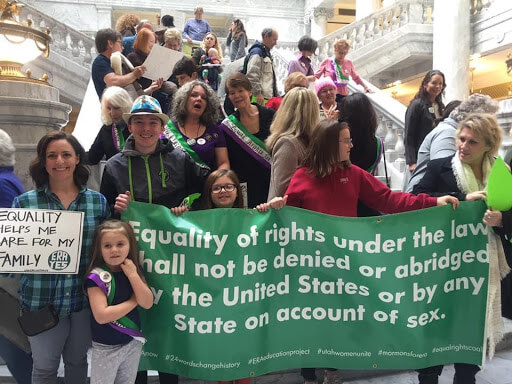
In a state, where 1 in 3 women experience domestic violence vs. 1 in 4 women in the nation, Utah has work to do to ensure women’s safety. The ERA will bolster respect for women and provide better legal protection against harassment in professional life, and in the home. This amendment ensures that equal treatment laws cannot be walked back, watered down, and reversed by the whims of one court, one administration, or one Executive Order. The Violence Against Women Act, a bi-partisan bill since 1994 was defunded by Congress this year. It has enjoyed bi-partisan support for a decade. Our state uses those funds for Domestic Violence Resources and must now scramble to find alternative funding to cover these vital programs. The ERA would offer support for necessary federal acts like this one.
Title IX protections meant to protect against sexual assault on college campuses are being diluted. When an estimated 85% of campus sexual assaults go unreported, changes to settled federal law by Secretary of Education DeVos will increase barriers for assault victims to report violence and receive justice. Assault victims were excluded from this process of drafting new campus policies. The concerning impacts of these changes include;
- The conduct for sexual harassment must be “so severe, pervasive and objectively offensive” as to deny a person equal access to a school program or activity; (think about that level of proof).
- Requires victims to endure repeated and escalating levels of abuse before meeting the threshold for filing a complaint. (again, some may think this is a good change, but escalating levels–not just repeated).
- A victim is only entitled to protections against harassment if they were participating or attempting to participate in a school-controlled education program or activity in the United States. (Think how limiting this is)
- Tilts the scale in favor of respondents by offering schools the option of using a “clear and convincing evidence” standard in their Title IX cases. This is a higher burden and a dramatic deviation from the “preponderance of the evidence” standard that has previously been deemed appropriate and used by courts in all civil rights cases. This puts a heavy burden of proof on victims to prove their case and denies equality in the process.” (Why the higher burden than courts use?)
- Allows perpetrators to make public an incident that most survivors would prefer be kept private and within the confines of a confidential investigation and hearing. (Folks have wanted the defendant to be able to investigate, but this goes too far.)
- Gives more rights to the accused, “alleged student perpetrators will have added protections, including the presumption that they are innocent throughout the disciplinary process and the right to be provided all evidence collected against them.” (Where else do you get a presumption of innocence in a civil case? You don’t. If somebody sues you for sexual harassment in civil court, you don’t get a presumption of innocence).
- Allows schools that are governed by a religious organization to completely opt out of the Title IX rules, protections and process by asserting that the law is inconsistent with the religious tenets of the organization.
- Allows students to cross-examine their accusers and vice versa during live hearings, although it must be done through a lawyer or representative.
- Every state has adopted protections in the criminal justice process, known as rape shield laws, which recognize that a victim’s sexual history is irrelevant to determining consent in an incident of alleged rape. The new rules get rid of that shield. (Unacceptable).
The Equal Rights Amendment may potentially bolster and cement protections for assault survivors so they cannot be changed and diluted at the whim of one administration. See more about these changes that went into effect August 2020 here.
